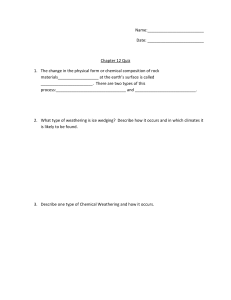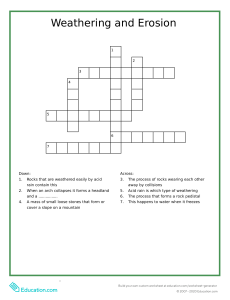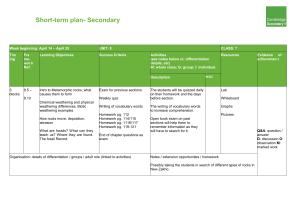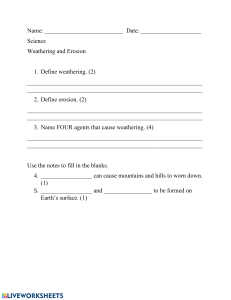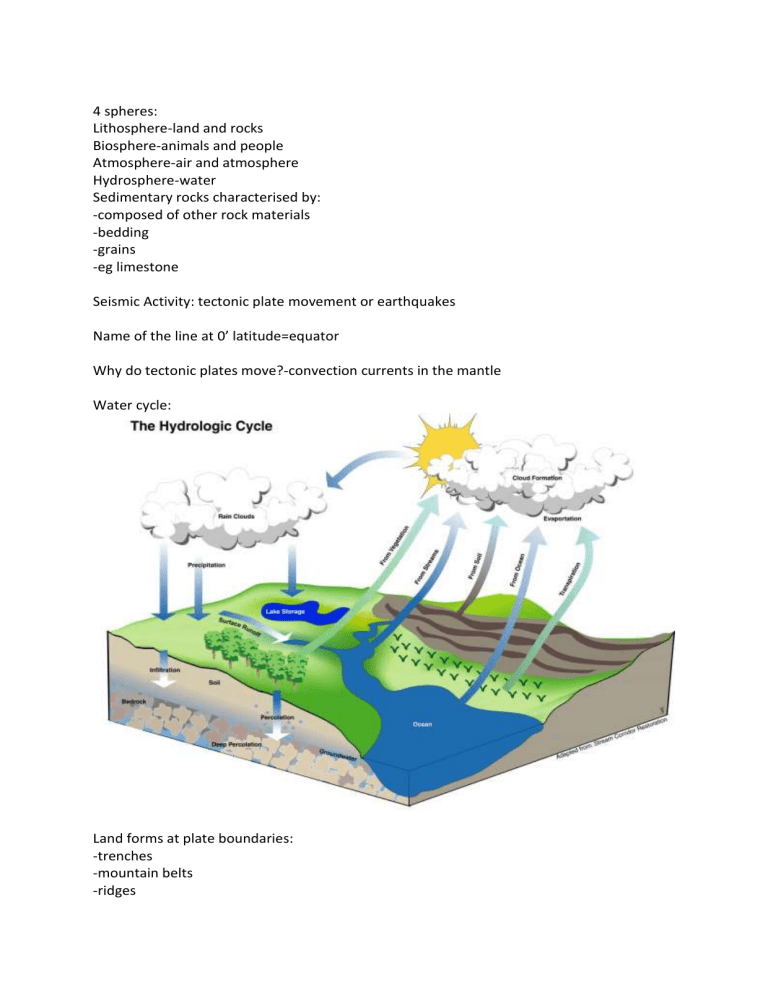
4 spheres: Lithosphere-land and rocks Biosphere-animals and people Atmosphere-air and atmosphere Hydrosphere-water Sedimentary rocks characterised by: -composed of other rock materials -bedding -grains -eg limestone Seismic Activity: tectonic plate movement or earthquakes Name of the line at 0’ latitude=equator Why do tectonic plates move?-convection currents in the mantle Water cycle: Land forms at plate boundaries: -trenches -mountain belts -ridges -volcanic arcs -volcanic island arcs Not associated with plate boundaries: -continental rifts -hot spots -continental basins -faults And Faults: a crack in the plate, weakness in crust Normal Reverse Strike slip Oblique Formations: River valley form: Glaciers create U shape Conversion plate boundaries Rock cycle: Intrusive and extrusive igneous rock Igneous-volcano Magma inside volcano Lava outside volcano Intrusive=larger crystals Extrusive=small crystals General circulation model: Dissolution: rainwater hits rock and breaks it down Carbonation: acidic rain or sea water breaks down a rock Rocko example 4 ways of weathering: -ice -tree roots -temperature -Biological contact Agriculture effect on earth w spheres -natural gases-biosphere and atmosphere, land destruction=biosphere, fresh water and chemicals impact hydrosphere, Rocks exposed at Earth’s surface are constantly changed by water, air, temperature variations and other factors • Weathering is the group of destructive processes that change physical and chemical character of rocks at or near Earth’s surface • Erosion is physical picking up of rock particles by water, ice, or wind • Transportation is the movement of eroded particles by water, ice, or wind • Atmosphere – Oxygen and carbon dioxide critical to chemical weathering – Water cycled through atmosphere is critical to chemical and mechanical weathering processes – Air in soils contributes to biological action that can produce chemical and mechanical weathering • Hydrosphere – Water is necessary for chemical weathering – Oxygen dissolved in water oxidizes iron in rocks – Carbon dioxide dissolved in water creates carbonic acid • Primary cause of chemical weathering – Running water loosens and abrades particles – Glacial ice removes and abrades particles – Freeze/thaw cycling mechanically weathers • Biosphere – Plant root growth widens cracks – Animal foot traffic and human activity mechanically weather – Decaying organic matter in soils produces acidic soil moisture FACTORS affecting weathering Not all rocks are the same and therefore have different susceptibility to weathering • Some rock material is porous (voids) - allows weathering agent to break down rock - can be spaces between grains or fractures, joints or bedding planes • Some rocks are permeable – example limestone. Weathering agents like water can flow through (important for aquifer formation) • • • Slope: force of gravity (for example water flowing down a steep versus water flowing down a gentle slope). Temperature: higher temperatures can speed up the reaction rate for weathering to occur. Animals: example of burrowing animals, hard hooved animals etc. General Circulation Model Influenced/complicated by four important features: • Difference in temperature between equator and polar regions (as before); • Differences in the amount of land and water in each hemisphere; • Seasonal variation in the Sun’s movement (revolution and rotation around tilted axis). • Rotation of the Earth. 3 main types of circulation cells 3 main wind zones – easterlies, westerlies and trade winds Atmospheric Moisture: Dew Usually originates from terrestrial radiation Moisture condensation on surfaces that have been cooled to saturation point Will appear as water droplets Frost Occurs when air temperature lowers to saturation point, when the saturation point is below 0°C Will appear as large numbers of small white crystals PRECIPITATION: Originates from clouds Condensation insufficient to form raindrops Other processes important Collision/coalescence—tiny water drops in cloud collide and merge to form larger drops Types of precipitation Rain: liquid water Snow: cloud ice crystals Sleet: snow melted and frozen again before hitting land, ice pellets Glaze (Freezing Rain): water falls as liquid, freezes to surfaces Hail: strong updrafts are required • • • • • • • Which of the following is an intrusive igneous rock? The proportion of organic matter, air, minerals and water in a fertile soil should be: Sedimentary rocks are characterised by: Seismic activity relates to the occurrence of: Movement of tectonic plates is believed to be due to: Which of the following is the correct name for dunes of Swan Coastal Plain? How is climate determined by the angle of the suns rays reaching the Earth surface? Include the main climatic subregions and the name of the ‘line’ at 0° Latitude. (4 marks) • Provide a diagram and brief description of the rock cycle (5 marks) • Briefly describe 3 types of chemical and 3 types of physical weathering (6 marks) Explain the difference between weathering and mass wasting (2 marks 1. Describe how the interactions between the 4 Earth spheres have shaped the landscapes that we see today. (15 marks) 2. Compare and contrast the landforms indicative of divergent and convergent tectonic plate boundaries. (15 marks) What is global warming and how will it impact each of the 4 Earth spheres at present and predicted for the future.
